Landscaping is an important part of campus life for any Northeast Ohio college or university.
The campus landscape, like its distinctive buildings, represents the educational facility’s values and becomes a vital part of campus life, providing a space for aesthetics, outdoor events, gathering, study, and play.
The campus landscape even becomes a factor in student recruitment. In fact, more than 200,000 students answering an EAB Enrollment Services survey chose the campus environment as their No. 1 reason for making their decision to go to a specific college or university. This ranked higher than academic reputation and even cost. And USA Home Remodeling says 62% of students made their college choice based on appearance alone.
Since university landscapes are very visible and accessible, landscape planning, maintenance, and attention can build awareness and promote learning for the entire educational and local community.
When a university is well-maintained with eye-catching landscaping, it can not only raise the interest level of the school, it can also create an environment students are drawn to. Studies show when schools have more attractive landscapes, they draw more students, enrollees’ grades improve, and campus safety amplifies.
The University of Michigan did studies that showed when students were surrounded by engaging landscapes, it also helped their mental health and scholastic performance.
The word “campus” was first used to describe the outdoor spaces at Princeton University because they had a unique character. The landscape continues to define a college’s identity. It also adds to the student's quality of life where they can decompress between courses, meet with fellow students after class, and shape their overall academic experience.
If you want to take advantage of these benefits on your campus or university, but aren’t sure where to start or how to achieve landscapes like those educational facilities you admire, then this guide is for you. Here, we dive into essential areas of great campus landscaping and offer tips on how to maximize them for better campus living.
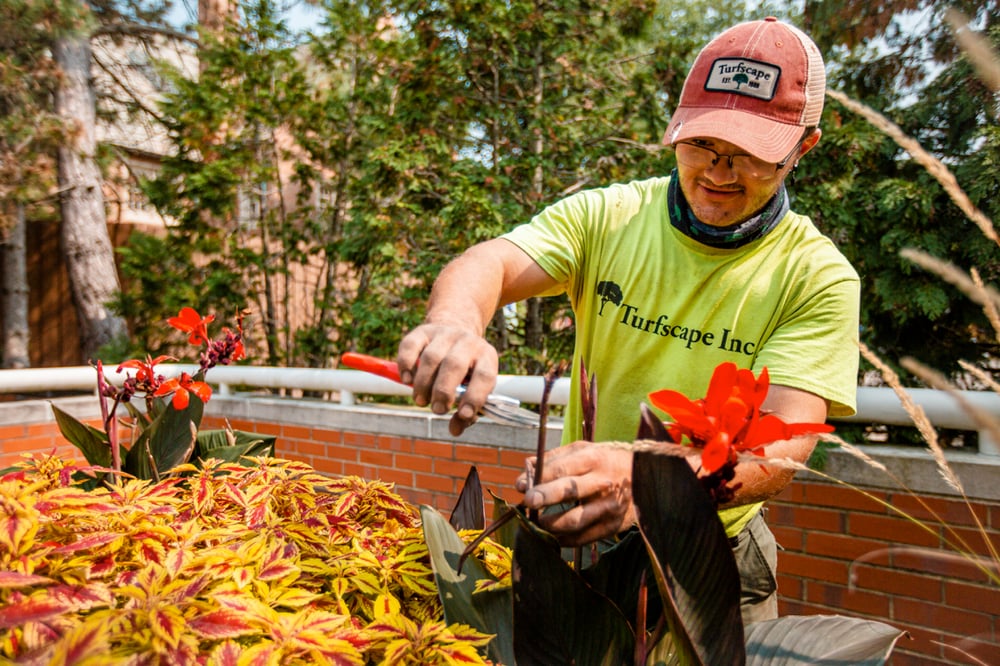
Maintaining a college is more than keeping its indoor learning classrooms in order. It’s also about upholding a healthy outdoor environment. Well-maintained school grounds can add to the educational experience for your students, as well as enrich the lives of those in the local community.
The thought of having to constantly monitor your outdoor spaces, in addition to indoor cleanup and maintenance, can sound expensive and feel overwhelming. But how you design your landscape and the plants you choose can not only help you stick to your budget, but also simplify your job of keeping these spaces tidy.
Here are a few steps you can take to ensure your campus is maximizing its landscaping.
When students are choosing their college or university, they seek a welcoming, engaging environment. In this way, the right landscaping can elevate your school environment and drive student enrollment.
After all, this learning environment becomes a second home for a period of time for these students. That’s why one professor’s research found that students can decide in as quickly as 10 minutes on campus whether that school is for them. That’s why 62% of students base their college decision on the appearance of campus buildings and landscapes.
The right landscape design should do the following for your university landscaping:
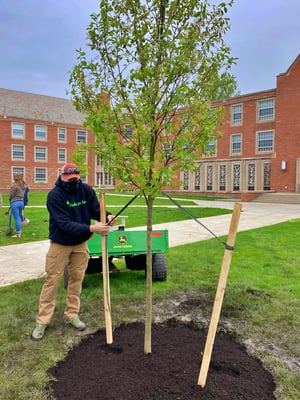 Choosing the right trees and shrubs can mean all the difference when you consider all of your maintenance needs, facility goals, and how you want to beautify your landscape for the best of everyone who works at, visits, or attends your school.
Choosing the right trees and shrubs can mean all the difference when you consider all of your maintenance needs, facility goals, and how you want to beautify your landscape for the best of everyone who works at, visits, or attends your school.
Too frequently, commercial facilities, schools included, will choose the wrong tree or shrub for the wrong place. This is what leads to a high-maintenance, unsightly problem on your campus.
An area’s soil conditions, traffic, sunlight, and water or drainage give you a guide for what species will work best there. Then you also have to look at the specific habits of that tree or shrub, such as its growth expectations; sunlight, water, and soil needs; and fruiting or flowering habits. Matching these two things will give you optimum results for a school landscape design.
Turfscape recommends these 5 trees and 3 shrubs that provide great property aesthetics while being sturdy, strong and low maintenance on Northeast Ohio campuses.
Plant in well-drained soil; fertilize annually; and add mulch to retain moisture, control soil temperatures, and suppress weeds.
While we’ve tested and seen how well the above plants work in college and university landscapes, we know there are a lot of options out there. As such, you might have your eye on other species you’ve seen while touring other campuses.
When you’re choosing plants for your educational facility landscape, the last thing you want to do is pick a tree or shrub that underperforms or becomes a maintenance hassle. Avoid the following plant qualities to keep your maintenance demands and budget in check.
Picture the Stanford University campus. Sure, it’s known for world-renowned academics, but it also boasts an iconic Stanford “S” of red flowers, ornately decorated with other reds, whites, and greens, in its quad -- the heart of the campus, its oldest and most iconic section. Why these colors? Because black, white, and cardinal are the school’s colors -- its pride and joy. What better way to exhibit school spirit?

School colors and spirit give every Northeast Ohio college or university unique chances to dress up their landscapes through the seasons with punchy tones and textures in highly visible outdoor spaces.
Here are some other ways color can dress up your campus.
When alumni reflect on their college days, they often recall meandering through campus pathways as they went to and from classes, studying while lying in open grassy fields, or hanging with friends in outdoor nooks as a break from their busy schedules.
It’s the outdoor spaces that they cherish most. While a university is a place of learning, it is also an environment where students develop identities. The setting in which they learn and grow can help them maintain a balance between the pressures and expectations of college work and getting adequate rest. That’s where outdoor common areas and classrooms can serve as places for getting fresh air, easing tension, encouraging recreation and physical activity, and boosting social interactions and dialogue.
Does your Northeast Ohio college or university have an irresistible common area? A place where students can go for a break from the stress of classes or a fresh-air study session? Or maybe you have an outdoor common area, but no one uses it?
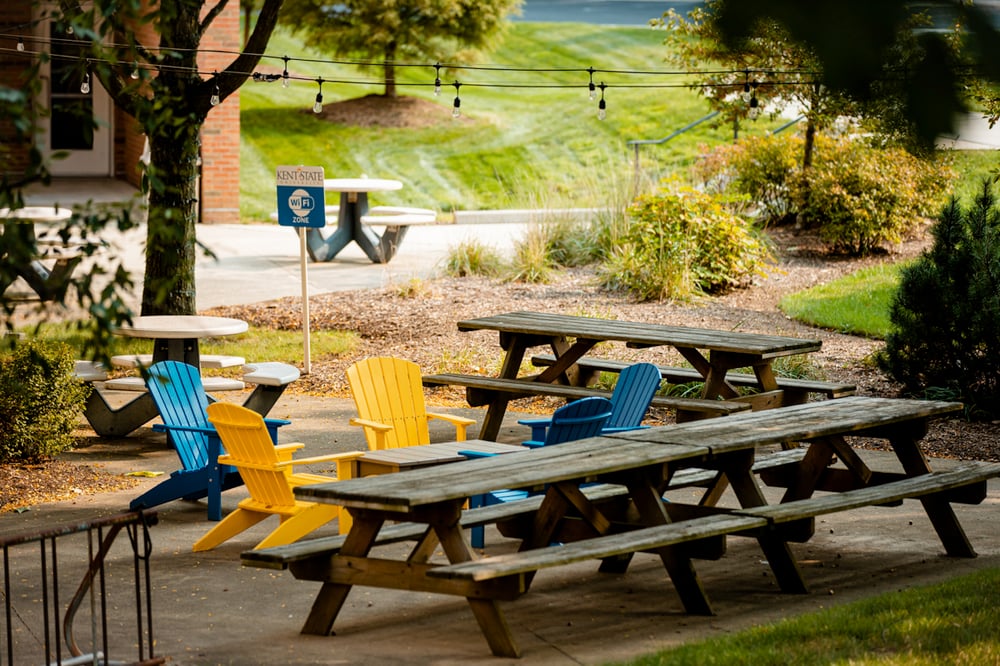
There are some essential design elements that make college campus landscaping special, attracting students and faculty. Try these ideas to help elevate your common areas.
Include a Patio Space. A patio can create an appealing way to encourage students to gather, enjoy lunch, or take breaks between classes. The options are endless when it comes to patio styles, including pavers, bricks, and stones. Depending on the styles of your college buildings, choosing one that coordinates can set the right base for a great gathering spot.
Provide Seating. When students, faculty, and guests look for places to meet on a college campus, they are usually looking for spots with seating. Choose seating that blends with your current campus style. Think stone benches, picnic tables, or sturdy and trending outdoor furniture. You can even incorporate built-in seating in your retaining walls.
Add Shade and Color. While the sun’s warmth is welcome on many days, shade is where it’s at when it comes to long outdoor study sessions. Shade trees and nearby plantings can create lovely design elements throughout the seasons by bringing pops of color and interest that provide cooling cover from the sun, as well as greenery to ease stress. In addition, containers full of blooms that change with the seasons can make the space feel special -- like an outdoor room.
Encourage Movement. Great common area college landscaping includes multipurpose areas. Walking trails that encourage exercise and connect campus sections give students chances to stretch out their legs after sitting in classes for hours.
Incorporate Lighting. College courses happen early in the morning and later in the evening. Study sessions happen at all hours. Landscaping lighting can ensure safety as students and faculty move from one building to another through the dim hours, as well as extend the usable hours of college campus landscaping.
Offer a Wireless Connection. Polishing papers, joining Zoom calls with fellow students, or looking up essential study facts can all be easily done by providing wireless connections in your campus common areas. For instance, John Carroll University in University Heights, Ohio, provides an outside study area with work tables that have solar panels and charging stations for its students to use.
Outdoor spaces on school campuses have long been used for studying, gathering, and networking.
So it's natural for educators and facility managers to make the jump to creating teaching landscapes. These spaces embrace the idea that building interiors can extend into natural or created outdoor areas to provide more informal areas for learning.
Outdoor classrooms should enhance opportunities for teachers to develop their skills and objectives, as well as for students to better absorb the material. The experience can also make both teaching and learning fun.
Here are some ways you can extend your teaching environment beyond the classroom walls onto campus grounds.
Stressful situations are a part of school life, particularly in college. University students face a range of challenging situations as they transition to campus life -- from employment to living arrangements to navigating relationships and academics. Research shows a positive relationship between the use of green spaces and reduced stress. Being in green spaces can stabilize blood pressure, lower heart rate, and reduce muscle tension. And reduced stress has been linked to improved academic performance.
Outdoor classrooms can incorporate these stress-reducing plants and environments in creative ways. Nearby landscape beds can include plants that provide hands-on gardening opportunities, showing different types of species or growing conditions. They can also include habitats for birds and butterflies with plants friendly to these species, as well as other accessories, such as bird feeders made by students.
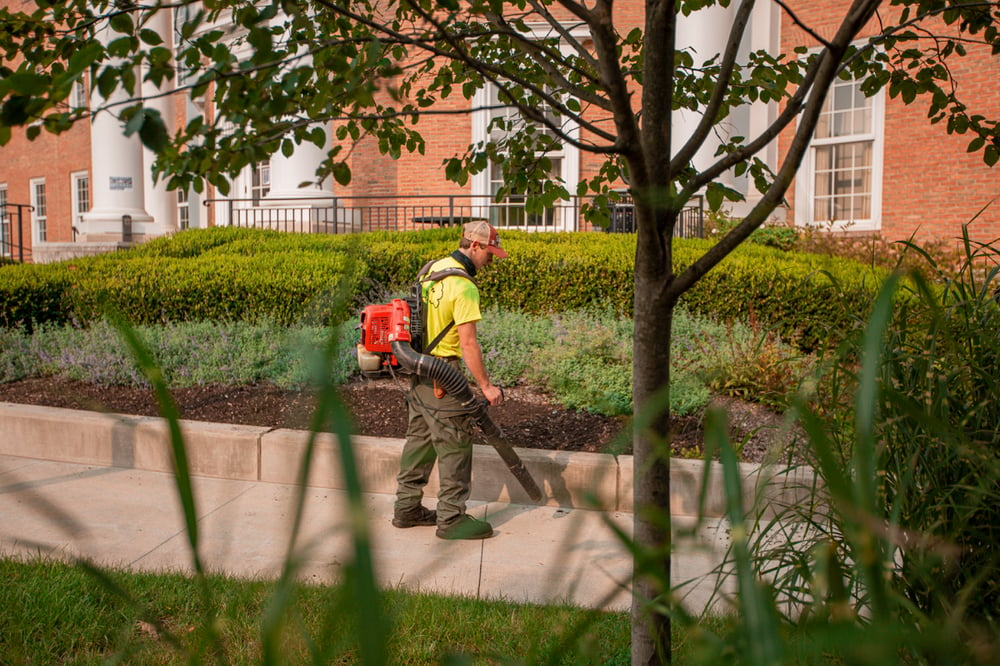
Nothing makes a person feel more welcome and cozy than feeling safe and secure.
Since students are on campus from early morning hours until late at night, feeling comfortable moving about campus all day long is so important to their decision to attend a particular college or university.
Outdoor tasks that boost this feeling include:
These tasks limit liability for colleges and universities, in addition to making students feel more at home and protected.
Sure, the school itself is the main focus when it comes to higher education. It needs to have the requirements necessary to provide students with expertise in their majors and areas of study.
But while they are spending that time on campus intensely learning, a well-maintained, eye-catching landscape can be exactly what they need to relieve stress while studying. College curb appeal is a motivating factor when it comes to why students choose your school. It shows you care about the space in which they are learning, their education, and how their environment can impact that learning process.
When well-maintained university grounds can attract students, enhance campus safety, and improve grades, focusing on better campus landscaping each year can be well worth the effort.
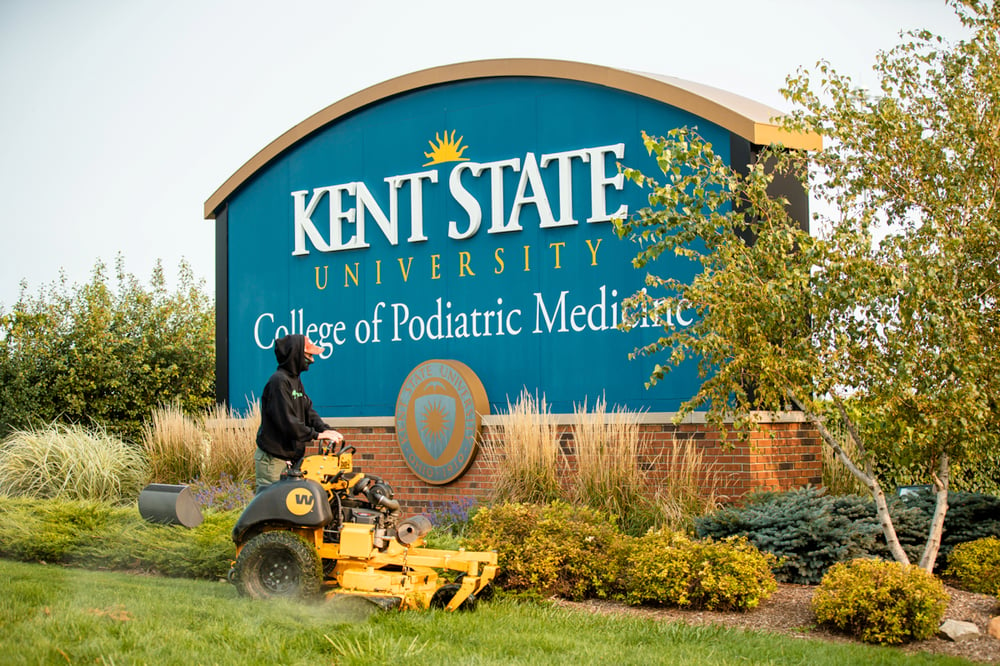
When it comes to campus grounds maintenance, you want a proactive approach that includes lawn care, mowing/maintenance, trash patrol, spring and fall cleanup, and regular pruning, as well as seasonal color boosts and enhancements.
As you can imagine, it’s hard for us to state an exact college landscaping cost as there are so many variables based on the campus’ needs and size. Some colleges spend anywhere from $50k to $200k+ depending upon the scope of work.
While you might think these services will be the same from one company to the next, there are a few factors that will impact college grounds maintenance costs.
We want to help you understand where your budget dollars are going with a look at some of the key elements you should seek in a contract, as well as some items that can influence the total price of your college landscaping costs.
Services & Scope. Mowing, edging, fertilization, pruning, mulch installations, spring and fall cleanups -- your college landscape maintenance contract should naturally list the services that your service professional will perform. But how often are these services performed? And what locations are included?
Your contract should include the basic services, as well as any additional value they include. Edging and pruning, for instance, should be mentioned as included services, so you aren’t nickeled and dimed for these tasks later. Outline your expectations for how you like your lawn mowed, as well as any specifics necessary for special areas. For pruning, outline areas that are important for visibility that you’d like kept clear. Cleanup may involve removing fallen branches, as well as picking up trash. Think about what areas you’d like freshly mulched each year and how often to keep your campus looking sharp. Frequency is also important to discuss. Mowing may be weekly, but pruning may be something you want to be done when there is overgrowth.
These are details a landscape professional should be happy to discuss with you, so expectations are clear.
Landscape Colors & Special Requests. A college or university attracts students and retains them by having a look and feel that is all its own. As such, your landscape maintenance contract should outline specifics in landscape design and maintenance that are important to your educational facility’s brand and reputation. For instance, you may want to provide your landscape professional with a plant palette you prefer based on school colors. If you don’t already have this in place and would like to create it, your landscape professional should also be able to help you do that.
Communication & Partnership. With colleges and universities, not only are their facility managers to satisfy, but there are also administrators, educators, professors, and students that can ask questions and nitpick services. Your landscape professional should know how to work with and respond to inquiries from people on campus to maintain the property and relationships, keeping in touch with you about this feedback and any suggested next steps and budget impacts.
It’s also helpful if the same crew leaders and crews are on your property regularly because they know it best and can build those relationships, remembering key areas of concern.
Long-term Contracts. Signing a multi-year contract with a landscape professional can be an option that works better for you than short, transactional contracts. Through multiple years, a contractor gets to learn about your site, watching it go through multiple growing seasons and weather conditions. This process can reveal weak areas or trouble spots that become targets for improvement. Also, a three-year commercial landscape maintenance contract typically locks in a price for all three years, which is helpful in future budget planning. So if there’s a project you want to work on -- maybe a renovation of an outdoor gathering area or campus hotspot that needs attention -- you can phase out that renovation strategy and the dollars necessary to complete it. A three-year contract also saves you the time of putting out RFPs and reviewing, analyzing, and responding to bids every year.
A harsh and unpredictable Northeast Ohio winter can especially wreak havoc on a college or university campus that needs to clear ice and snow from its entryways to make traffic flow seamlessly on and off its property throughout the day. Sidewalks and parking lots also need to be open and accessible to keep students, faculty, and visitors safe throughout the winter season.
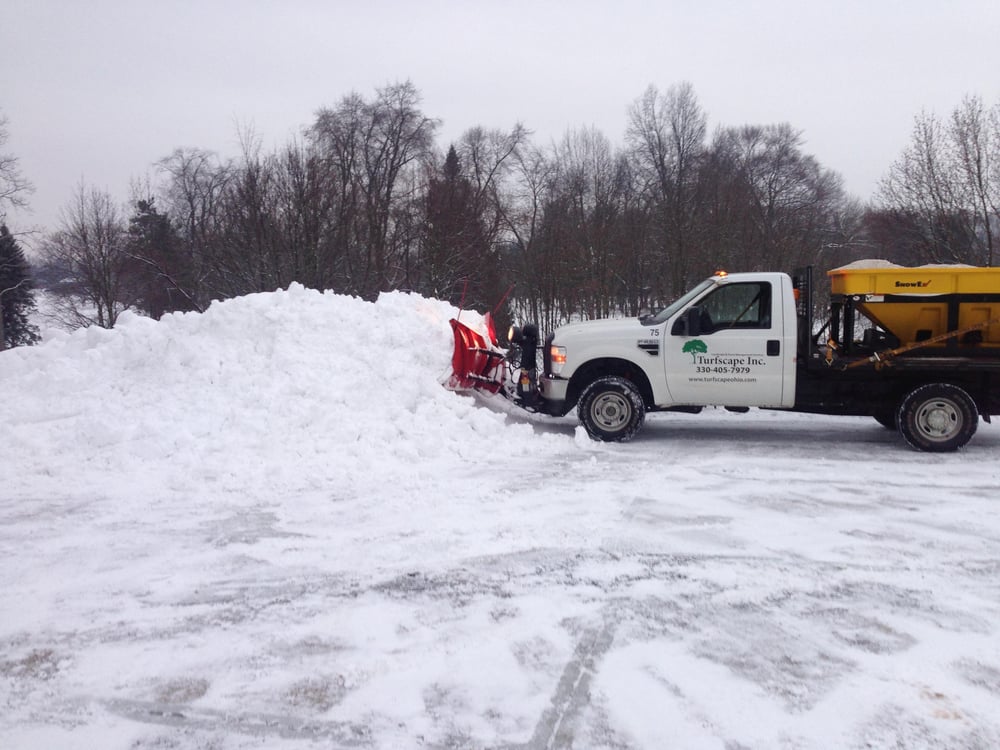 When a storm hits in the middle of the night, you want to know you did everything you could while planning in advance to ensure your campus is functioning smoothly come morning rush hour.
When a storm hits in the middle of the night, you want to know you did everything you could while planning in advance to ensure your campus is functioning smoothly come morning rush hour.
Here are the essentials to include in your commercial snow removal contract, so you’re not left adrift when that big snow and ice storm hit your campus.
Timing. In Northeast Ohio, commercial snow removal contracts typically run from December 1st through March 31st every year. This should be stipulated in your contract and should fall naturally in line with when your regular landscape maintenance services begin and end. However, as some surprise snow and ice storm occurrences in the area have taught us, winter weather can begin and end at any time. Once you have a signed contract in place, your service provider should be able to accommodate you during storms that fall outside of this contract window because it’s part of the season and part of creating a satisfactory, long-lasting relationship and partnership with you.
Scope of Service. The specific services you need on your campus during these colder months is also a natural and essential part of a commercial snow removal contract. Many companies offer snow removal services in different ways: a per-occurrence contract or a seasonal contract. A per-occurrence contract means that you pay each time we plow or salt the property. The contract can also deem how high that snow needs to be for them to plow. Typically, this is set at 2 inches or above, but if you are particularly worried about the safety hazards that snow and ice can cause, you can discuss 1-inch snow heights with your provider. An all-inclusive or seasonal contract means you pay a monthly rate for four months and no matter how many snow and ice events occur, you are covered. Your snow removal services provider will be there.
Some companies like Turfscape will even offer combinations of the two contract types to fit your specific property needs and budget. For instance, maybe you need an all-inclusive contract for snow removal but would prefer to only have salt for removing ice after each plow versus at other times. You have the option of customizing a contract to fit your needs. The goal here is you want a clear idea of service expectations. Your contractor should be asking about the traffic flow on your property and what you want to be done and when, as well as what areas are most important to clear first. Those answers will help dictate the best plan for you.
Equipment Needs. Some larger colleges or universities find it is even more important in their commercial snow removal contract to include provisions for equipment that is kept on their sites to streamline snow and ice maintenance even further. Contracts focusing on this will include what’s called a monthly “ready fee” for equipment to sit on their site “at the ready.” Crews then just show up to your campus and equipment is ready for them to use.
Above-and-Beyond Stipulations. Some winters can be especially harsh. There are times when snow piles will get too high. At that point, you may actually need the snow removed from your property for safety purposes and to keep your campus running smoothly.
This is when your commercial snow removal contract should include a stipulation that dictates an hourly rate for these above-and-beyond services. The reason these services are excessive and cost extra is that your service provider will need to bring in extra equipment, such as skid-steer loaders or a front-end loader and a dump truck, to actually get that heavy snow off of your property. A contract may also list another hourly rate for hand-chipping ice on your property. The crew would need to do this if the ice gets so thick that they can’t melt it using other methods.
While these types of extras are rare, knowing your costs upfront in case a bad winter is on its way is important so you’re not caught off-guard later.
You may find yourself looking at several bids on the table, detailing landscape maintenance plans for your college or university.
And you have to compare the similarities and differences and make a final decision. But, unfortunately, no two contracts are worded exactly the same, making this process challenging, adding to your already long list of things to do.
At the end of the day, you just want to hire a company that has the same high standards for quality work that you do in other areas of your campus. After all, the landscape firm you hire will be a partner -- an extension of your property management team.
We get it -- the pressure you feel making this decision just built up to another level. Don’t panic. We’re here to make this process easier for you. Let’s look at some things you should pay special attention to when choosing your landscape service provider.
Details Matter. Campus maintenance programs can vary greatly based on the size of your space, as well as the level of complexity and attention required. All of this can influence college grounds maintenance costs.
When a landscape company estimates your project, multiple staff members should be spending from between 100 to 500 hours on your property doing the preliminary work necessary to give you the best plan and price possible. They do this to get the best feel for traffic and pedestrian flow on your site, as well as focal areas that need refinements. They walk the site to get a feel for its safety. They identify critical areas for snow and ice management. They measure the site. They ask questions of you and your team and welcome questions in return. They do their homework on what is most important to your university and its core values.
For instance, with one of Turfscape’s college maintenance clients, John Carroll University, social justice was very important to them. This was why Turfscape’s Giving Back program, which has been making a local difference in Northeast Ohio through charitable donations and volunteer efforts since 2004, was a segment of the partnership they valued. This became an essential part of the relationship. Make sure your landscape professional knows what’s most important to you and your college environment during this exploration process as you factor in your college maintenance costs.
Your Landscape Professional Becomes an Extension of Your Team. Whether your campus is large enough to require a dedicated crew of multiple team members each day or the weekly presence of a landscape crew, your professional landscape team should become an extension of your university staff.
Your campus is a living, breathing space with constant movement from vehicles and pedestrians throughout the day. Part of your college landscaping costs includes having a crew that is sensitive to the timing of various events on your property, as well as regular classes, meetings, and busy times and spaces. This includes turning off equipment when large groups of people are passing by and cleaning off mowed areas before moving on to the next to ensure each campus segment remains tidy and reflects a positive presence.
Crew Experience & Communication Are Important. The professional landscape crew members who perform work on your campus are the most essential parts of keeping your college looking good, positively boosting your image and enrollment, and proactively meeting your demands, and suggesting improvements within your budget restraints. As a result, labor is the largest expense of a service-based company and can impact college landscaping costs. Therefore, you want to know you are getting professionals who are worth the price. Just like anything else, lower prices could mean less experienced crews unfamiliar with the specifics of college campuses who are also paid at lower rates.
Experience also means knowing how to regularly walk your property, looking for improvements, and proactively addressing any maintenance issues.
Keeping in touch with you is also crucial to understanding your changing challenges and needs. For instance, Turfscape’s field managers attend weekly campus facility meetings to ensure they don’t miss anything important to the college. The account manager is also on-site at least weekly for quality control. Then, a supervisor or executive will visit quarterly to check the pulse of the university vice presidents and managers and ensure things are running smoothly.
Finding a business that you can count on to bring fresh ideas, follow through on promises, and do amazing work on your college or university campus may feel overwhelming.
We understand that. The last thing you want to do is research many businesses and then be dissatisfied with your decision or the results. You have people to answer to, and you don’t want to waste time or budget dollars choosing the wrong landscape service provider and then have to go through the process all over again -- all while the landscaping at your college or university suffers.
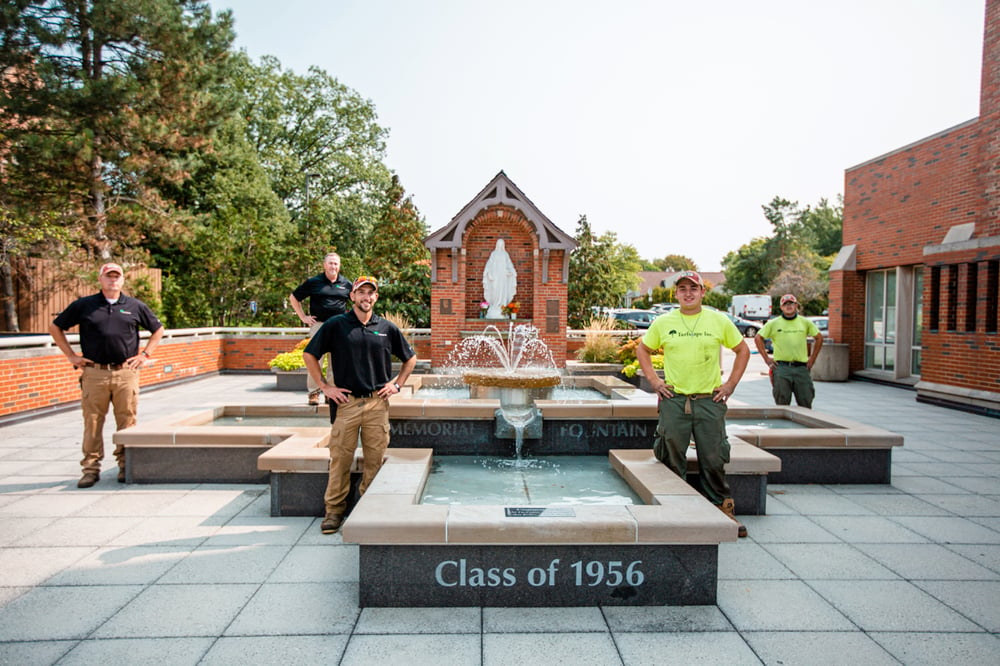
As you compare the top commercial landscaping companies in Northeast Ohio, we hope you’ll consider Turfscape in your search. We started our business in 1988 with the goal of providing responsive commercial landscape services to the Northeast Ohio community. Our focus has always and will always be on commercial landscaping because we believe maintaining that core focus makes us better.
These differentiators are what set us apart from the competition.
Our Employee Tenure. Advancement from within is a major focus of our core employment philosophy. That means the people in our management positions have all worked their way up from field crew members. Most of our managers are also landscape industry certified with a certified landscape technician or a certified landscape professional designation, as well as licensed in pesticide applications.
We firmly believe that when we take care of our commercial landscaping company team members, they take better care of our customers.
Our Team Takes Pride in Continuous Improvement. We believe maintaining employee training elevates our quality control and customer service, which we feel is important in every single commercial landscaping company job. Every morning before each day starts, we do a morning huddle, discussing best practices, seasonal changes and tips, and safety reminders. Our account managers and field supervisors are also out in the field all day checking on crews, critiquing, and teaching service techniques.
Our Focus on Customer Communication. Communication is something facility managers appreciate and crave. You don’t want to have to guess what was done or what’s going on or if something will be done on your property. That’s what you are hiring a professional for. At Turfscape, we appreciate consistent and regular communication, too. That’s why we guarantee same-day communication with our customers. This doesn't always mean we can solve your problem in 24 hours, but we will text, email, or call you back, depending on your preference, and let you know we’re aware of your question or issue and that we’re working on it.
Internally, we take this communication piece very seriously as well. In our process, work is not marked complete until it’s communicated to the client as complete. Until we reach out to you and let you know a problem was resolved or a project is considered finished, it is not filed as complete in our office. This is to ensure that communication is not forgotten or neglected. We refer to this process as “closing the communication loop.”
SO YOU CAN FOCUS ON WHAT YOU DO BEST